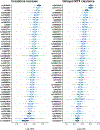Novel and replicated clinical and genetic risk factors for toxicity from high-dose methotrexate in pediatric acute lymphoblastic leukemia
- PMID: 36764694
- PMCID: PMC10085626
- DOI: 10.1002/phar.2779
Novel and replicated clinical and genetic risk factors for toxicity from high-dose methotrexate in pediatric acute lymphoblastic leukemia
Abstract
Study objective: Methotrexate (MTX) is a key component of treatment for high-risk pediatric acute lymphoblastic leukemia (ALL) but may cause acute kidney injury and prolonged hospitalization due to delayed clearance. The purpose of this study is to identify clinical and genetic factors that may predict which children are at risk for creatinine increase and prolonged MTX clearance.
Design: We conducted a single-center, retrospective cohort study of pediatric patients with ALL who received 4000-5000 mg/m2 of MTX. Measurements We performed germline genotyping to determine genetic ancestry and allele status for 49 single nucleotide polymorphisms (SNPs) identified from the literature as related to MTX disposition. Bayesian hierarchical ordinal regression models for creatinine increase and for prolonged MTX clearance were developed.
Main results: Hispanic ethnicity, body mass index (BMI) < 3%, BMI between 85%-95%, and Native American genetic ancestry were found to be associated with an increased risk for creatinine elevation. Older age, Black race, and use of the intensive monitoring protocol were associated with a decreased risk for creatinine elevation. Older age, B- compared to T-ALL, and the minor alleles of rs2838958/SLC19A1 and rs7317112/ABCC4 were associated with an increased risk for delayed clearance. Black race, MTX dose reduction, and the minor allele of rs2306283/SLCO1B1 were found to be associated with a decreased risk for delayed clearance.
Conclusions: These predictors of MTX toxicities may allow for more precise individualized toxicity risk prediction.
Keywords: leukemia; methotrexate; nephrotoxicity; pediatrics; pharmacogenomics.
© 2023 Pharmacotherapy Publications, Inc.
Conflict of interest statement
Conflict of interest:
Dr. Bernhardt has received compensation as a member of a scientific advisory board for BTG International. All other authors declare no conflicts of interest.
Figures


Similar articles
-
The Role of Candidate Polymorphisms in Drug Transporter Genes on High-Dose Methotrexate in the Consolidation Phase of the AIEOP-BFM ALL 2009 Protocol.Clin Transl Sci. 2025 Feb;18(2):e70136. doi: 10.1111/cts.70136. Clin Transl Sci. 2025. PMID: 39891427 Free PMC article.
-
Novel risk factors for glucarpidase use in pediatric acute lymphoblastic leukemia: Hispanic ethnicity, age, and the ABCC4 gene.Pediatr Blood Cancer. 2021 Aug;68(8):e29036. doi: 10.1002/pbc.29036. Epub 2021 Mar 31. Pediatr Blood Cancer. 2021. PMID: 33788417 Free PMC article.
-
Effects of SLCO1B1 on elimination and toxicities of high-dose methotrexate in pediatric acute lymphoblastic leukemia.Pharmacogenomics. 2022 Oct;23(15):821-834. doi: 10.2217/pgs-2022-0098. Epub 2022 Oct 4. Pharmacogenomics. 2022. PMID: 36193736
-
Methotrexate Disposition in Pediatric Patients with Acute Lymphoblastic Leukemia: What Have We Learnt From the Genetic Variants of Drug Transporters.Curr Pharm Des. 2019;25(6):627-634. doi: 10.2174/1381612825666190329141003. Curr Pharm Des. 2019. PMID: 30931851 Review.
-
Systematic review: genetic polymorphisms in the pharmacokinetics of high-dose methotrexate in pediatric acute lymphoblastic leukemia patients.Cancer Chemother Pharmacol. 2024 Aug;94(2):141-155. doi: 10.1007/s00280-024-04694-0. Epub 2024 Jul 13. Cancer Chemother Pharmacol. 2024. PMID: 39002021
Cited by
-
Clinical Risk Factors for High-Dose Methotrexate-Induced Oral Mucositis Following Individualized Dosing.Cancer Med. 2024 Nov;13(21):e70351. doi: 10.1002/cam4.70351. Cancer Med. 2024. PMID: 39485718 Free PMC article.
-
Integration of genomics, clinical characteristics and baseline biological profiles to predict the risk of liver injury induced by high-dose methotrexate.Front Pharmacol. 2024 Nov 28;15:1423214. doi: 10.3389/fphar.2024.1423214. eCollection 2024. Front Pharmacol. 2024. PMID: 39669197 Free PMC article.
-
The Relevance of Telomerase and Telomere-Associated Proteins in B-Acute Lymphoblastic Leukemia.Genes (Basel). 2023 Mar 10;14(3):691. doi: 10.3390/genes14030691. Genes (Basel). 2023. PMID: 36980962 Free PMC article. Review.
References
-
- Siryk A, Grunwald H, Brahim A, Gentile F, Shenderov F, Ballestas C. Impact of Ethnicity on Toxicities Associated with Dose Escalating Methotrexate in Pediatric Patients with Acute Lymphoblastic Leukemia. Blood. 2019. Nov 13;134(Supplement_1):5074–5074.
-
- Widemann BC, Adamson PC. Understanding and Managing Methotrexate Nephrotoxicity. The Oncologist. 2006;11(6):694–703. - PubMed
-
- Lopez-Lopez E, Ballesteros J, Piñan MA, Sanchez de Toledo J, Garcia de Andoin N, Garcia-Miguel P, et al. Polymorphisms in the methotrexate transport pathway: a new tool for MTX plasma level prediction in pediatric acute lymphoblastic leukemia. Pharmacogenet Genomics. 2013. Feb;23(2):53–61. - PubMed
Publication types
MeSH terms
Substances
Grants and funding
LinkOut - more resources
Full Text Sources

